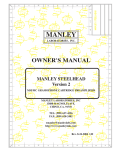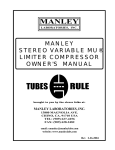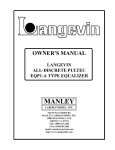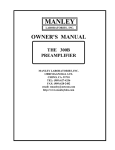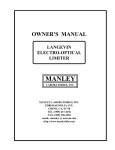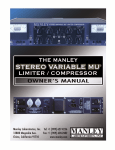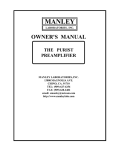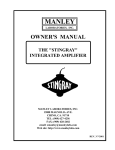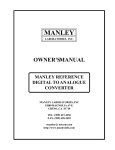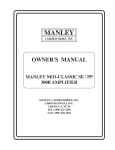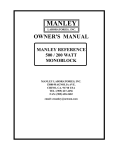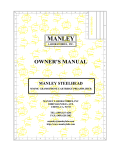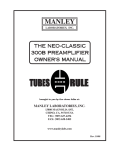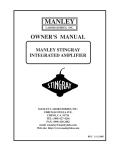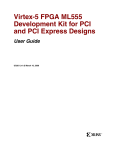Download Manley LANGEVIN DUAL Owner`s manual
Transcript
OWNER'S MANUAL LANGEVIN DUAL MONO MICROPHONE PREAMPLIFIER WITH EQ MANLEY LABORATORIES, INC. MANUFACTURED BY: MANLEY LABORATORIES, INC. 13880 MAGNOLIA AVE. CHINO, CA. 91710 USA TEL: (909) 627-4256 FAX: (909) 628-2482 email:[email protected] http://www.manleylabs.com REV 4-3-2006 CONTENTS SECTION PAGE INTRODUCTION 3 MAINS CONNECTIONS 4 BASICS 5 CONNECTING YOUR PREAMPLIFIER 6 FRONT PANEL 8 REAR PANEL 9 TECH NOTES 10 SPECIFICATIONS 11 WARRANTY 12 WARRANTY REGISTRATION 13 APPENDIX A: WIRING YOUR OWN CABLES APPENDIX B: TEMPLATE FOR STORING SETTINGS INTRODUCTION THANK YOU!... for choosing the Langevin Dual Mono Microphone Preamplifier. Manley Labs bought all the rights to the Langevin name and circuits in 1992. Manley Labs uses the Langevin name for its solid state products including versions of an all discrete Pultec and Electro-Optical Limiter, as well as, other high performance non-tube products. This Mic Preamplifier uses an all discrete transistor audio path that simply sounds pretty damn good. We believe it is because the circuit has good audio performance before any negative feedback was used to lower the gain and further improve noise and distortion. This Microphone Preamplifier is a low cost way to enjoy good old high-end performance. It is built to the same standards as the Manley gear and uses all of the same top quality components. It is one of the best alternatives for those needing a superb stereo mic pre but for whatever reason cannot get the Manley Tube Mic Preamp. The Langevin preamplifier also has useful tone shaping (EQ), (fused) phantom power and very high reliability. Thank you again, and please enjoy! WATER & MOISTURE As with any electrical equipment, this equipment should not be used near water or moisture. If liquid enters the preamplifier, it must be immediately returned to your dealer for servicing. SERVICING The user should not attempt to service this unit beyond that described in the owner's manual. Refer all servicing to Manley Laboratories. WARNING! TO PREVENT THE RISK OF ELECTRIC SHOCK DO NOT OPEN THE CABINET REFER SERVICING TO QUALIFIED PERSONEL ! 3 MAINS CONNECTIONS Your unit has been factory set to the correct mains voltage for your country. The voltage setting is marked on the serial badge, located on the rear panel. Check that this complies with your local supply. The voltage changeover switch is located inside the unit in the middle of the PCB near the power transformer. To change the voltage from 120 to 240 volts, simply remove the top cover by unscrewing the center fixing screw and sliding the top out towards the rear of the chassis. Turn the top of the voltage changeover switch with a firm positive action using a small flat screwdriver. Export units for certain markets have a moulded mains plug fitted to comply with local requirements. If your unit does not have a plug fitted the coloured wires should be connected to the appropriate plug terminals in accordance with the following code. GREEN/YELLOW BLUE BROWN EARTH NEUTRAL LIVE terminal terminal terminal As the colours of the wires in the mains lead may not correspond with the coloured marking identifying the terminals in your plug proceed as follows; The wire which is coloured GREEN/YELLOW must be connected to the terminal in the plug which is marked by the letter E or by the safety earth symbol or coloured GREEN or GREEN and YELLOW. The wire which is coloured BLUE must be connected to the terminal in the plug which is marked by the letter N or coloured BLACK. The wire which is coloured BROWN must be connected to the terminal in the plug which is marked by the letter L or coloured RED. DO NOT CONNECT/SWITCH ON THE MAINS SUPPLY UNTIL ALL OTHER CONNECTIONS HAVE BEEN MADE. 4 BASICS This Microphone Preamp, like most mic preamps, is pretty easy to use. First we can discuss why outboard mic pre's have become "a must have item" in almost every studio even though your console probably has a bunch of them and that manufacturer claims that they are really great and you don't need outboard mic pre's. Then, why is everybody buying them, using them, and why are most people going back to tubes or vintage transistor based circuits? Good question. The signal from a typical mic is very low - anywhere from 20 to 70 dB below your normal line level signals. 95% of the time 30 to 40 dB of gain is all that is needed to boost the signal to line levels. Where you really need a lot of gain is with most ribbon mics and when you are recording chamber music from a distance. Mic signals are fragile and raw. The fragility is apparent when one compares various mic pre's - each preamp seems to sound different - no EQ, no compression, nothing elaborate - just basic gain. Maybe it is the mic reacting different into different circuits. Each preamp, tube or solid state seems to impart a flavour or color (or personality) of its own. Some of these flavours are subtle and some are not. A few engineers have an array of mic pre's and use them almost like effects - using each for a certain flavor as needed. The rest of us only have the budget for one or two great mic pre's so we tend to choose one that sounds "best", or is priced for us, or is used by "xxxxxx". The Langevin Microphone Preamplifier is superb sounding probably because it has a simple all discrete gain stage with a minimum of components and a minumum amount of negative feedback. Specifications, while important, will not be truly indicative of an audio product's "sound" until methods of determining the transient accuracy are established. Transient accuracy is not a "spec" and test benches don't produce hit records. The transient details are important for reproducing the true character of the instrument, the room and stereo image. Most solid state circuits use a large amont of negative feedback to lower noise and distortion at the cost of transient accuracy. This preamplifier started out clean and quiet so minimal negative feedback was necessary. Op-amp based designs, by comparison, have dozens of transistors in each "chip" (its easier to fabricate a transistor than a resistor on silicon), hundreds of dB's of negative feedback and sometimes a few discrete transistors to provide performance that an "IC" simply cannot. The result is good specs - but that harsh, hard, cold sound that makes shakers sound like pink noise, makes vocals sibilant in an unpleasant way, and can only render a 2 dimensional image at best. We prefer tubes or simple discrete circuits. We mentioned mic signals are fragile and raw. Some consider that the "headroom" factor is the most important issue in mic pre's. We believe that it is just one of a number of issues including the harmonic character of the distortion. Except for the final output, all circuits are "Class A" which is usually associated with no crossover distortion and near clipping will be even order distortion and less upper harmonics.This Preamplifier has more headroom than most solid state mic pre's because of the 48 volt power supply used, compared to 30 volts (+/- 15V or 24 volts) used in other designs. If overdriven, which is not easy, it starts to clip in a gentle, smooth way. Which brings us to the next topic - METERING - We do get questions like "How do I set up the Mic Pre levels when there are no meters?". Answer - Look at where you are sending the signal, if it has meters - use them. Why ? Most people are recording to digital mediums where there is no real standard. If you use the tape machine's digital meters, you will most likely get the best recording levels using the machine's meters. If we included a meter, it would most likely not be "calibrated" to your meters and mislead or confuse the user. Also, if we included metering, it would be VU which is a standard of its own appropriate for analog tape only. Turn up the LEVEL control until the loudest peaks to tape are a few dB below maximum and not producing "Over" Leds (for safety) and not too low (10 dB below clipping or lower). If we had a "Clipping LED" for the preamp, it would be probably be dark when the machine's meters were pinned. Cosmetically a meter might be nice but functionally it would be misleading or mostly useless. 5 CONNECTING YOUR PREAMPLIFIER Easy - Connect the mic to the Microphone Input XLR, then connect the Line Output to your tape machine or console. Read on, there are some things to consider. On the back panel are female XLR's labelled MIC INPUT A and MIC INPUT B. The signal from the MICROPHONES get plugged in here. Here are a few warnings and suggestions. These XLR connectors also "send" PHANTOM POWER to the mics. Some mics can be damaged by the 48 volts of phantom power. A few PZMs and a few ribbon mics have been known to "fry" when fed phantom power. The suggestion is to ALWAYS have PHANTOM switched off when switching mics, cables, patches that involve mics etc. You ONLY use phantom power for PRO SOLID STATE "FET' CONDENSOR MICS. Tube mics, dynamic mics, ribbon mics and battery powered mics should have phantom switched "off". This is true for all mic pre's. With this MIC PRE you "PULL THE TOGGLE to SWITCH PHANTOM". It is a locking toggle to prevent "accidents". The second great reason for not using phantom if you don't have to is that - if you change a connection with phantom on, then the pre amp will be fed a quick burst of 48 volts (when it normally is amplifying about a hundredth of a volt), which can then be monitored - usually once. After you have replaced your speakers, you have learned a valuable lesson about turning down the volume of the monitors before changing mics or mic patches. This is a good idea with phantom on or off. Consider a variation of this any mic connection just a little bit bad,will be extra noisy with phantom turned on. This goes for cables, patchbays, patch cords etc. Suggestion #2 - Avoid running mic signals through patchbays. Some patchbays "ground" all the "sleeves" which can add a ground loop into your delicate mic signal. Suggestion #3 - Set up the Mic Pre in the studio near the mic and use a short mic cable. Why ? Microphones often have "light duty" line drivers and you can lose an audible amount of signal in long cables. You can get the best fidelity by having the Mic Pre close to the mic at the "cost" of having to walk into the studio to adjust a level control. You also avoid almost all of that phantom power / patching problem because now you are patching a regular line level signal only. The INPUT & OUTPUTS XLR PINOUTS are: PIN 1 = CIRCUIT GROUND PIN 2 = HOT or positive going phase PIN 3 = LOW or negative going phase The OUTPUTs are simple and balanced. They will feed balanced inputs but not unbalanced inputs "correctly". When one is plugged into an unbalanced input, expect a 6 dB loss of output level. This will occur no matter how you wire the cable. The best way to drive an unbalanced input with this unit is not to connect to PIN 3 at the output XLR - just use PIN 1 (ground) and PIN 2 (signal). Better to have PIN 3's signal float than short. You may not notice the 6 dB "loss" because the preamp still has good headroom. NOTE: The DIRECT INPUT comes in AFTER the INPUT ATTENUATOR. It comes in at the wiper (output) of the INPUT ATTENUATOR pot into the first transistor. Thus when you turn down that INPUT ATTENTUATOR you are moving that point closer towards ground and loading down that DIRECT INPUT. This will indeed affect frequency response. Solution: keep the INPUT ATTENUATOR UP (fully clockwise) when you are using the DIRECT INPUT. 6 Reversing the polarity or phase is often needed when two or more mics are picking up the same source. For example it would be needed when one mics the top and bottom of a snare - one skin is going towards one mic and the other skin is going away from the other mic. If one signal is not "reversed" then you lose lows. Polarity reverse can also help with some vocal / mic / headphone situations because " somewhere " the polarity flipped one too many times. It happens. General advise - try it each way - listen, with vocals, always ask the singer which way they prefer. The headphones may "cancel" with the sound they hear in their skull while singing. This Mic Pre has no provision for changing the polarity. If you are recording direct to tape it is a good idea to have a few phase reverse adapters on hand. All you need is two XLRs (a male and female) and a foot of mic cable. It doesn't matter which end is which. Wire it up as follows: PIN 1 (Shield) > PIN 1 PIN 2 > PIN 3 PIN 3 > PIN 2 You can use this between the MIC and PREAMP or often between the PREAMP and TAPE. If you use both at once, you come out in phase. Mark these cables PHASE REV ! This is another reason why a 1 foot cable is good - thus avoiding confusion with normal cables. We did include a 1/4 inch phone jack input for electronic instruments. This is not quite the same thing as a direct box because the input impedance is about 23K ohms compared to 1M ohms of a typical DI - which means it sucks for guitar and bass. It is intended for the dozens of synths and drum machines in many rooms. It provides a good input with gain control and EQ. You can use either the INSTRUMENT INPUT or MIC INPUT but not both at the same time. On the wiring PIN-OUTS, you may have noticed we specified CIRCUIT GROUND rather than just GROUND. We have a few terminals on the back panel for various "ground schemes". The CIRCUIT GROUND is the same ground as the electronics in the Mic Pre while the CHASSIS GROUND is the same as the steel enclosure that is bolted to the rack and is also connected to the "third pin AC Mains Ground. Both terminals are normally connected together with a small "ground strap" but this strap can be moved to the side and wire can be attached to the terminals. These are "MINI BANANA" style and will not accept regular size bananas found on electronic test gear. Be careful with the ground strap because it can get lost if the terminals are loose. If it does get lost - you can use a short bare wire. There are two good reasons for using these ground terminals. The first is finding and fixing hum and the second is preventing hum. If you have plugged everything in right and you are getting hum then you have a number of options with these terminals. You can try simply moving the strap so that chassis ground is separate from circuit ground. This is similar to breaking off the third pin AC ground but includes the ground from rack mounting . One can experiment with attaching a wire between the console ground and the circuit ground or between a rack and the chassis ground. These are all techniques some technicians use when wiring studios. They also often cut the ground (shield) on one side of the cable to prevent loops. DO NOT cut the shield on MIC cables because you lose phantom, shielding at the mic, and hum only gets worse ! One other cause of hum - Some gear may radiate a field into whatever is closest. Move the Mic Pre or the offender away from each other. That may help. 7 FRONT PHANTOM 48V INPUT 80 Hz ATTENUATE 40 Hz A B L.F. -10 EQ IN +10 EQ OUT C D H.F. -10 PANEL POWER PHANTOM 48V 80 Hz 12 KHz +10 E 8 KHz DISCRETE DUAL MONO MICROPHONE PREAMPLIFIER F G I J 40 Hz K L.F. -10 EQ IN +10 EQ OUT L M H.F. -10 12 KHz +10 N 8 KHz O INPUT ATTENUATE P A&P INPUT ATTENUATE This is the input level for the microphone signal. The best setting is achieved by watching the meters of the recording machine as you adjust this control. B&K LOW FREQ. SELECT Selects low frequency to be boosted or cut (80 Hz or 40 Hz). C&L LOW FREQUENCY ADJUST Continuously variable low frequency adjust from 10dB to +10dB. D&M EQ IN / EQ OUT Selects EQ in the circuit or BYPASSED completely. E&N HIGH FREQUENCY ADJUST Continuously variable high frequency adjust from 10 dB to +10dB. F&O HIGH FREQUENCY SELECT Selects between 8 and 12 KHz peak adjust. Boost or Cut for this selection is adjusted by controls E or H. G&H PHANTOM SUPPLY SWITCH PULL this switch to unlock to change phantom power (48 volts) for each channel. The phantom switch locks to prevent accidental switching when phantom power is not desired. NEVER apply phantom volts to an unbalanced source (some battery powered and tube mics are unbalanced). I POWER SWITCH & LED Switch up to power ON the unit, down to power OFF the unit. LED Illuminates when unit is powered on. 8 REAR PANEL A B C D E F G H I A INSTRUMENT INPUT Optimised for Synths and drum machines but not for guitars or basses. Use a regular "DI" into the MIC INPUT for guitars and basses. Use only the instrument input or MIC INPUT but not both at the same time. B INPUT XLR (Right Channel) Balanced XLR input. PINOUT: Pin 1 Ground Pin 2 POSITIVE going phase (+) Pin 3 NEGATIVE going phase (-) C OUTPUT XLR (Right Channel) Balanced XLR output. PINOUT: Pin 1 Ground Pin 2 POSITIVE going phase (+) Pin 3 NEGATIVE going phase (-) We do not recommend that this output be used with unbalanced inputs. If you have to - do not connect PIN 3. D FUSE HOLDER To remove the fuse, push and turn the fuse holder cap. A 1/2 Amp SLO-BLO fuse is recommended. In fact, ONLY replace with the same type and value for safety. E IEC MAINS SOCKET Accepts standard 50/60 Hz AC mains voltage. The correct voltage should be factory set for your country. If it needs to checked or changed, there is a switch inside the unit for 110 or 220 VAC operation. See page 10. F GROUND TERMINALS Use these terminals to solve hum problems. See page 7. Normally these terminals are joined by a "ground strap". G OUTPUT XLR (Left Channel) Balanced XLR output. PINOUT: Pin 1 Ground Pin 2 POSITIVE going phase (+) Pin 3 NEGATIVE going phase (-) We do not recommend that this output be used with unbalanced inputs. If you have to - do not connect PIN 3. H INPUT XLR (Right Channel) Balanced XLR input. PINOUT: Pin 1 Ground Pin 2 POSITIVE going phase (+) Pin 3 NEGATIVE going phase (-) I INSTRUMENT INPUT Optimised for synths and drum machines but not for guitars or basses. For guitars use a regular "DI" into the MIC INPUT. Use only the instrument input or MIC INPUT but not both at the same time. 9 TECH NOTES PHANTOM POWER FUSE In earlier sections we explained most of the possible small disasters that can happen when phantom power is used. The big one is damage to other gear not designed for phantom. This includes old ribbon mics, non-pro battery powered mics and possibly other things we have yet to hear about. FOUR reasonable rules: 1) Most modern mics with 3 pin XLR connectors will be safe and there is no need to worry unless you own some exotic or real cheap mics. 2) ONLY FET condensor mics need phantom power and some direct boxes can either use it or use batteries. 3) Because usually phantom power is not needed, leave it off to prevent excessive noise from poor connections & cables and because some mics that don't need phantom sound slightly better with it off. 4) ALWAYS turn the monitors down when you turn phantom power on or change a mic or mic cable or mic patch. How can I tell when I need phantom? There will be no signal at all from the mic. However this might be caused by any number of reasons (cables). If you have lost phantom power in this mic pre (the phantom LED won't light) it is very likely because somebody broke one of the above rules. It happens. There is a fuse inside the unit for these situations and it has blown. Unplug the AC then, replace the fuse with another AGC 4/10 A (fast blow) and you are back in business. INTERNAL TRIMS The drawing below shows the location of the LINE VOLTAGE SELECT for you international engineers (110 or 220). It also shows the locations of the phantom fuse, channel gain trims and power supply trims and test points. These are all factory set and it is very unlikely that they will ever need to be adjusted or changed. LINE VOLTAGE SELECT TRIM1 TRIM01 C202 CHAN A GAIN PHANTOM FUSE AGC 4/10 AMP FAST BLOW CHAN B GAIN (FACTORY SET FOR 45 DB) TRIM201 POWER SUPPLY 48 VDC ADJUST 10 GROUND +48 VDC SPECIFICATIONS Frequency Response 10 Hz to 20 KHz (+/- 1 dB) THD & Noise .1% Signal to Noise ratio 103 dB Headroom 27 dB (ref +4 dBv) Maximum Output +31 dBv (75 volts p to p) Maximum Input (with Input at max) 84 mV Maximum Gain (factory set for 45 dB) 38 dB to 53 dB (internal trimmer) Input Impedance (1Khz @ +10 dBm) 2400 Ohm, transformer coupled (optimised for mics with 100 to 600 ohm output impedances) 23,000 Ohm @ 1/4" input Output Impedance 11 Ohms (balanced) XLR Pin-Out (balanced) (not appropriate for driving unbalanced inputs) PIN 1 = Ground or Shield PIN 2 = HOT (+) PIN 3 = LOW (-) Power Consumption 12 watts Size 19" X 1.75" X 10" (1U) Shipping Weight 12 lbs 11 WARRANTY All Manley Laboratories equipment is covered by a limited warranty against defects in materials and workmanship for a period of 90 days from date of purchase to the original purchaser only. A further optional limited 5 year transferrable warranty is available upon proper registration of ownership within 30 days of date of first purchase. Proper registration is made by filling out and returning to the factory the warranty card attached to this general warranty statement, along with a copy of the original sales receipt as proof of the original date of purchase, or registration can be made online in the Tech Support section of www.manleylabs.com. This warranty is provided by the dealer where the unit was purchased, and by Manley Laboratories, Inc. Under the terms of the warranty defective parts will be repaired or replaced without charge, excepting the cost of tubes. Vacuum tubes and meter or badge lamps are warranted for six months provided the warranty registration is completed as outlined above. If a Manley Laboratories product fails to meet the above warranty, then the purchaser's sole remedy shall be to first obtain a Repair Authorisation from Manley Laboratories and return the product to Manley Laboratories, where the defect will be repaired without charge for parts and labour. All returns to the factory must be in the original packing, accompanied by the Repair Authorisation, and must be shipped to Manley Laboratories via insured freight at the customer's own expense. Factory original packaging can be ordered from Manley Labs. Customer will be charged for new factory original packaging if customer fails to ship product to Manley Labs in the original factory packaging. After repair, the product will then be returned to customer via prepaid, insured freight, method and carrier to be determined solely by Manley Laboratories. Manley Laboratories will not pay for express or overnight freight service nor will Manley Laboratories pay for shipments to locations outside the USA. Charges for unauthorized service and transportation costs are not reimbursable under this warranty, and all warrantees, express or implied, become null and void where the product has been damaged by misuse, accident, neglect, modification, tampering or unauthorized alteration by anyone other than Manley Laboratories. The warrantor assumes no liability for property damage or any other incidental or consequental damage whatsoever which may result from failure of this product. Any and all warrantees of merchantability and fitness implied by law are limited to the duration of the expressed warranty. All warrantees apply only to Manley Laboratories products purchased and used in the USA. All warrantees apply only to Manley Laboratories products originally purchased from an authorised Manley dealer. Warranties for Manley Laboratories products purchased outside the USA will be covered by the Manley Importer for that specific country or region. "Grey Market" purchases are not covered by any warranty. In the case that a Manley Laboratories product must be returned to the factory from outside the USA, customer shall adhere to specific shipping, customs, and commercial invoicing instructions given with the Return Authorisation as Manley Laboratories will not be responsible for transportation costs or customs fees related to any importation or re-exportation charges whatsoever. Some states do not allow limitations on how long an implied warranty lasts, so the above limitations may not apply to you. Some states do not allow the exclusion or limitation of incidental or consequential damages, so the above exclusion may not apply to you. This warranty gives you specific legal rights and you may also have other rights which vary from state to state. For Tech Support and Repair Authorisation, please contact: MANLEY LABORATORIES, INC. 13880 MAGNOLIA AVE. CHINO, CA. 91710 USA TEL: (909) 627-4256 FAX: (909) 628-2482 email: [email protected] WARRANTY REGISTRATION We ask, grovel and beg that you please fill out this registration form and send the bottom half to: MANLEY LABORATORIES REGISTRATION DEPARTMENT 13880 MAGNOLIA AVE. CHINO CA, 91710 USA Or you may FAX this form in to: +1 (909) 628-2482 or you may fill in the online warranty registration form found in the Tech Support section of our website www.manleylabs.com or you can be really diligent and register your warranty three times to see if we get confused! Registration entitles you to product support, full warranty benefits, and notice of product enhancements and upgrades, even though it doesn't necessarily mean that you will get them (Just kidding!) You MUST complete and return the following to validate your warranty and registration. Thank you again for choosing Manley gear and reading all the way through The Owner's Manual. (We really mean that sincerely, the bit about thanking you for choosing our gear. THANK YOU!!!) MODEL _______________ SERIAL #__________________ PURCHASE DATE ______________ SUPPLIER ______________________ -------------------------------------------------------------------------------------------------------PLEASE DETACH THIS PORTION AND SEND IT TO MANLEY LABORATORIES MODEL _______________ SERIAL #__________________ PURCHASE DATE ______________ SUPPLIER ______________________ NAME OF OWNER _______________________________________________ ADDRESS ______________________________________________________ CITY, STATE, ZIP ________________________________________________ EMAIL: ________________________________________________________ TELEPHONE NUMBER___________________________________________ COMMENTS OR SUGGESTIONS?__________________________________ ________________________________________________________________















